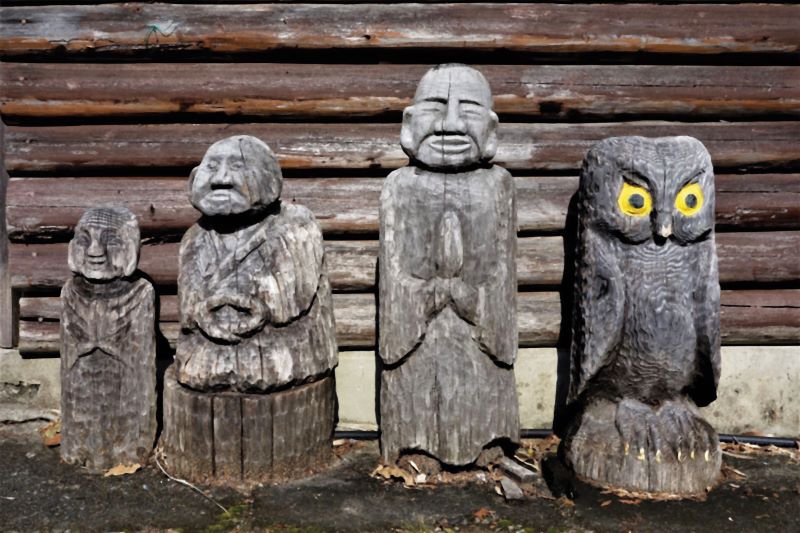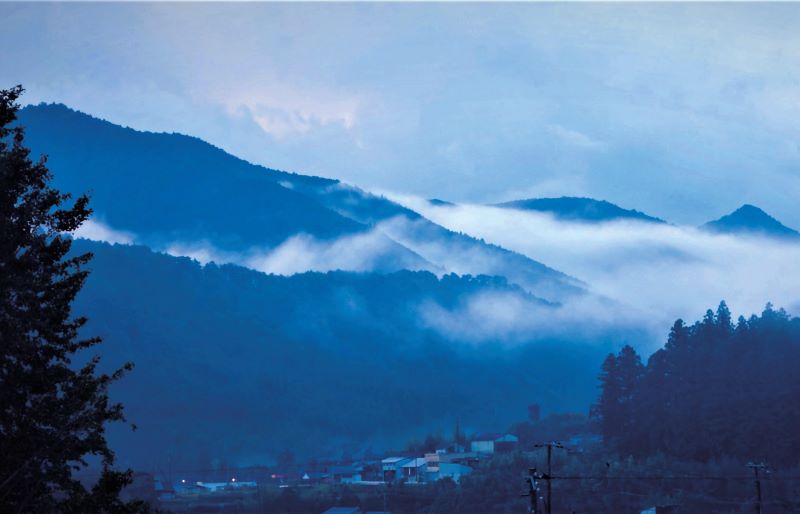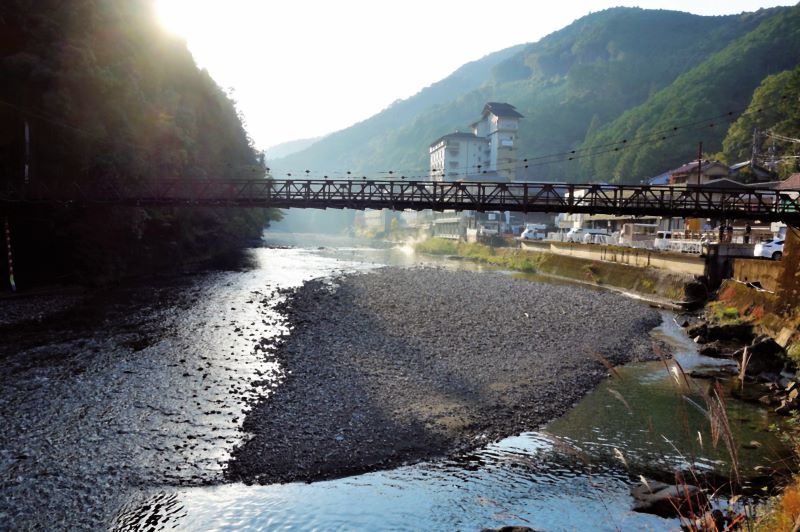
The Nachi-Taki waterfall behind the three-tiered pagoda has long been regarded as a symbol of life, linking heaven and earth (All photos: Lee Yu Kit)
In a copse of trees stood Takijiri-Oji, silent in the dappled shade of the forest. It was the first of many shrines I would encounter on the path that pilgrims trod 1,000 years ago on the Nakahechi trail of the Kumano Kodo pilgrimage route in Japan.
Besides the Santiago de Compostela route in Europe, the Kumano Kodo is the only other Unesco World Heritage-listed pilgrimage trail in the world. The name “Kumano” is a relic of the ancient name for the Kii Peninsula, the forested, mountainous area where the sacred Kumano Sanzan, or the three Grand Shrines, are nestled. Initially, the imperial family, and in later centuries, commoners, undertook the arduous pilgrimage, cleansing themselves spiritually along the way to these shrines, the final destinations of the pilgrimage.
The trail began behind the oji, which is a subsidiary shrine of the three Grand Shrines, for the guidance and protection of pilgrims who undertook purification rites here before their journey. I stepped into the cool shade of the forest, tall trees rising vertically around me. The afternoon light filtered through in a light, green veil. The path was apparent but stony and steep, and as the sound of the rivers faded behind me, it fell silent.
The path through the forest was marked by legends and milestones. Here was Chichi Iwa Rock, where legend has it that a nobleman left his newborn child, who was nurtured by the milk of a wolf 1,000 years ago. There were also small stone jizo statues, representations of Bodhisattvas, by the side of the trail to protect travellers.
river.jpg

A few hours later, I emerged from the forest into the mountain village of Takahara, comprising a few scattered wooden houses blended into the mountainscape and a panoramic view of the green hills rippling away. Shaded by huge trees in a hidden corner and framed by a Torii gate was Takahara-Kumano Jinja shrine, painted a bright vermillion.
I spent a comfortable night in a wooden-floored minshuku (guest house) with tatami mats on the floor and futon mattresses unfurled for sleeping, robed in the provided yukata (Japanese dressing gown) and slippers while indoors, dining on a bento meal with fellow travellers in the tatami-covered dining room in the evening.
The sun was brilliant, the sky blue and the temperature in the low teens as I continued my walk the next day, following a mountain stream into the quiet forest. Every day, I would meet hikers following the same section of the trail. We would walk together, and at other times, I would be alone.
The trail wended through different types of terrain, following leaf-littered winding mountain roads devoid of traffic, up and down, over log bridges and beside gurgling streams. I was on a self-guided hike with maps and trail notes, which was almost unnecessary as the path was meticulously signposted at each junction. Wooden boards marked with the legend “Not Kumano Kodo” indicated the path not to take.
carvings.jpg

I fell under the spell of the meandering path, luminously clear through the tangle of the forest and shifting shadows. I noticed the moss on the trees, the occasional sigh that passed through the forest, the damp patterns of leaves on the path, the silence of clearings where small shrines blended seamlessly into the green forest and ancient moss-covered miniature stone figures with sage features weathered by time.
There were ojis and jizos with colourful histories, like those of the traveller who perished from hunger and exhaustion here in the 19th century or the figurine of the 10th-century emperor riding a cow-horse.
In the early afternoon, I stepped into the bright sunlight and the village of Chikatsuyu, where pilgrims purified themselves in the waters of the cold shallow river that ran through the village before worshipping at the Chikatsuyu-Oji, shaded by massive old trees.
The village was quiet, with a population of just 500 people. As with much of rural Japan, an ageing population meant a slow decline in the number of inhabitants and a gradual increase in abandoned homes and fields.
A cheerful hostess, Naomi, served green tea, cooked dinner and made breakfast at her two-room guest house, equipped with modern amenities contrasting with the traditional tatami mats, futons and yukata.
chikatsuyu.jpg

In the morning, after the rain, mist veiled the mountains and the village like a timeless mystery.
Naomi drove me and her other guest to the start of our hike to spare us a bus ride, stopping along the way at Tsukizagura-Oji, named after a cherry tree grafted to a cypress tree in the 12th century. Massive cypresses soared high overhead, some of them as much as eight centuries old. The forest had once been filled with such giants instead of the jungle of slender boles that arose around me.
The present-day forests of Japanese cedar and spruce arose mainly after World War II, when the government initiated a massive planting programme to provide employment in the rural areas of the war-devastated country. Hundreds of thousands of wooden homes had been razed in the firebombing of Japanese cities by Allied bombers, and an exhausted population, demoralised and lacking housing, began to cut down natural forests for wood for rebuilding, replacing them with the managed forests that I walked through.
Naomi bade us goodbye after dropping us at the continuation of the path, which led to a mountainous section with isolated mountain trails. Mist rose from the mountains and dew dappled the trees, which were beginning to blush. It was lush and damp, and the moss underfoot absorbed our footfall.
The area of the Kii Peninsula has been considered sacred since prehistoric times. With the arrival of Buddhism in Japan in the sixth century, the syncretic mix of Shintoism and Buddhism led to the idea that the forested Kumano region represented the Buddhist Pure Land.
In the 11th century, emperors began to undertake the pilgrimage from the imperial cities of Kyoto and Nara. Over 100 trips were undertaken by the imperial families from the 11th to the 13th centuries, with large accompanying retinues.
Facilities such as shrines and large-scale accommodation became established along the pilgrimage routes. The Nakahechi trail, which I was walking, follows the imperial route.
I emerged from the damp forest at Hosshinmon Oji, another of the important shrines along the route.
sunlight.jpg

On approaching Fushiogami-Oji, on a small hillock, sections of the path were paved with rough stones, called ishidatami. The name means to “fall on knees and worship”, because from this vantage point, pilgrims obtained their first glimpse of their destination, the Kumano Hongu Taisha, one of the three Grand Shrines of Kumano.
For all the pilgrims who ever trod this route, the sense of anticipation must have increased, for the Grand Shrine was only 2km away. I walked past a neat graveyard, out of the forest and into another seemingly deserted village, down the road under a majestic Torii gate, and on to the shrine itself.
The Kumano Hongu Taisha shrine has been revered for over 1,000 years. It was busy in the compound after the emptiness of the trail. The outer shrine was a magnificent, graceful building with a gently sloping, complex roofline resolved by a central dangling rope attached to a bell before the main shrine. Beside this building was the huge wooden doorway to the inner shrine.
Within, the inner shrine buildings were old, majestic and austere at the same time, featuring long, sloping thatched roofs with golden highlights on the rows of jutting wooden beams, gigantic twists of rope and dark wooden slats obscuring what lay within. A large courtyard of fine white pebbles before the shrine buildings was an emptiness contrasting with the dark buildings and surrounding lush forests. It was a hiatus, a long pause, an emancipation of anticipation, a sudden sense of peace and completion after a long journey to this place of veneration.
A path down a long stairway and a large Torii gate led to a busy town at the other end of the shrine. I caught a bus for the short journey to Kawayu Onsen, a lovely little town sited on the side of a clear flowing river with natural hot springs along the banks. You could dig into the pebbly bank with a shovel for your own outdoor onsen.
kawayu.jpg

My accommodation was a large modern, yet traditional ryokan. The room was big and spacious, with a rotary phone, an analogue alarm clock, a yukata with a woollen overcoat against the cold, and a view of the river flowing languidly past with the dense forest beyond. The ryokan had dedicated indoor onsens for male and female guests. In the dining room, I sat down to a kaiseki dinner of awe-inspiring intricacy and beauty, twice consumed, once by the eyes and again by the mouth.
In the morning, I would begin the last leg of my journey, up the steepest section of the route, through cool forests, to the highest point of the Nakahechi trail, descending to a view of the coast and the Pacific Ocean beyond, and descending to Nachi Taisha, the second of the Grand Shrines. But that was for tomorrow.
Tonight, there was the silence and crisp cool of the night, the silhouette of the darkening forests against a glowing sky, and unseen in the gathering darkness, the eternal flow of the river coursing to destinations unknown.
This article first appeared on Apr 3, 2023 in The Edge Malaysia.


